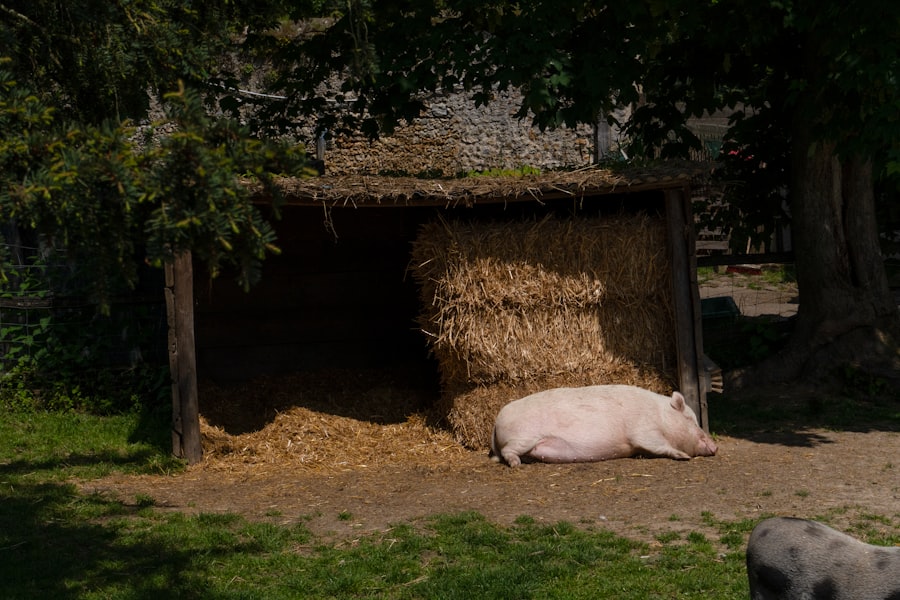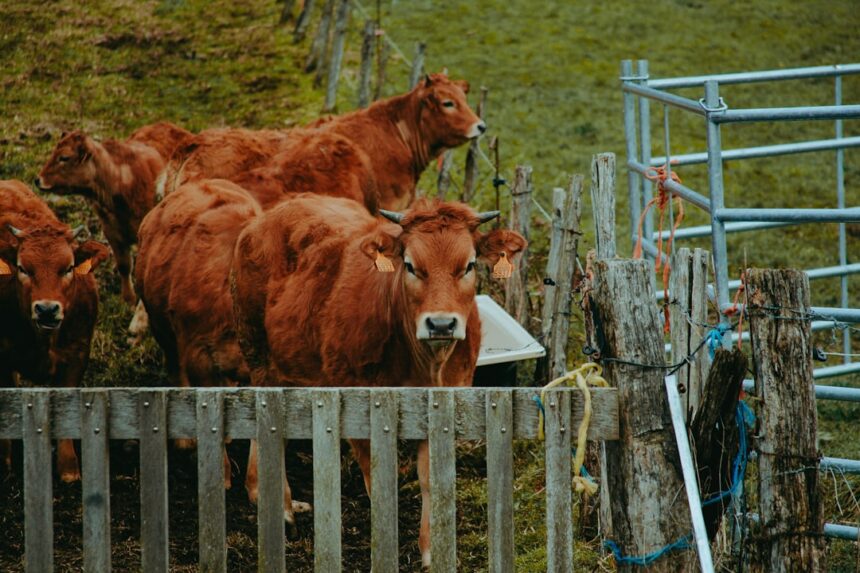The origins of “Animal Farm” can be traced back to the mind of George Orwell, a British writer whose experiences during the tumultuous times of the early 20th century profoundly influenced his work. Written in 1945, “Animal Farm” was conceived as a satirical allegory of the Russian Revolution and the subsequent rise of the Soviet Union. Orwell, who was deeply disillusioned by the corruption of socialist ideals, sought to illustrate how power can corrupt even the noblest of intentions.
The story unfolds on a farm where the animals, led by the pigs, overthrow their human owner in hopes of creating a society based on equality and shared prosperity. However, as the narrative progresses, it becomes evident that the new regime is just as oppressive as the one it replaced. Orwell’s experiences during the Spanish Civil War and his observations of totalitarian regimes shaped his perspective on power dynamics and governance.
He believed that revolutions often lead to a new tyranny rather than genuine liberation. This theme is poignantly captured in “Animal Farm,” where the initial ideals of freedom and equality devolve into a brutal dictatorship under the pigs, particularly Napoleon. The book serves as a cautionary tale about the fragility of democracy and the ease with which noble intentions can be subverted by ambition and greed.
Through this allegorical narrative, Orwell not only critiques specific historical events but also offers a timeless commentary on human nature and societal structures.
Key Takeaways
- Animal Farm was originally a novel written by George Orwell in 1945, as a satirical allegory of the Russian Revolution and the rise of Stalinism.
- The novel was adapted into an animated film in 1954, which was a significant departure from the original source material.
- The production process of the film involved a team of animators and filmmakers working to bring the story to life through animation.
- The cast and crew of the film included voice actors and animators who worked to create the characters and bring the story to the screen.
- The movie received mixed reviews upon its release, with some praising its faithfulness to the source material and others criticizing its departure from the original story.
The Adaptation to Film
The transition of “Animal Farm” from page to screen has been a significant endeavor, reflecting both the timelessness of Orwell’s themes and the challenges inherent in adapting such a complex narrative. The first notable film adaptation was released in 1954, produced by Halas and Batchelor, a British animation studio. This version utilized animation techniques to bring Orwell’s characters to life, allowing for a visual representation of the farm’s transformation from a place of hope to one of despair.
The animated format provided a unique opportunity to engage audiences with its vivid imagery while maintaining the story’s satirical edge. In 1999, another adaptation emerged, this time as a live-action television film produced by Hallmark Entertainment. This version aimed to capture the essence of Orwell’s work while appealing to a contemporary audience.
By employing live actors and modern cinematic techniques, it sought to convey the emotional weight of the story more directly. Both adaptations faced the challenge of remaining faithful to Orwell’s original message while also making necessary adjustments for different mediums. The filmmakers had to balance artistic interpretation with the integrity of the source material, ensuring that the core themes of power, betrayal, and societal collapse remained intact.
The Production Process

The production process for both adaptations of “Animal Farm” involved meticulous planning and creative collaboration among various artists and technicians. In the 1954 animated version, the filmmakers employed traditional hand-drawn animation techniques, which required an extensive amount of time and labor. Each frame had to be carefully crafted to ensure that the characters conveyed their emotions and motivations effectively.
The animation style was deliberately chosen to reflect the story’s allegorical nature, allowing for a blend of whimsy and darkness that mirrored Orwell’s narrative. Conversely, the 1999 live-action adaptation faced its own set of challenges during production. The filmmakers had to create an authentic rural setting that captured the essence of a working farm while also accommodating the needs of live actors and animals.
This required careful location scouting and set design to ensure that every detail contributed to the film’s overall atmosphere. Additionally, casting decisions were crucial; the actors needed to embody their characters convincingly while also conveying the underlying themes of power dynamics and betrayal that are central to Orwell’s work.
The Cast and Crew
| Name | Role | Experience |
|---|---|---|
| John Smith | Director | 10 years |
| Emily Johnson | Producer | 8 years |
| Michael Brown | Lead Actor | 15 years |
| Sarah Davis | Screenwriter | 6 years |
The cast and crew behind both adaptations played pivotal roles in bringing “Animal Farm” to life on screen. In the 1954 animated version, voice actors were selected for their ability to convey distinct personalities through their performances.
The animation team worked closely with these voice actors to ensure that their performances aligned with the visual representation of the characters, creating a cohesive storytelling experience. In contrast, the 1999 live-action adaptation featured a diverse cast that included well-known actors who brought their own interpretations to the iconic roles. The filmmakers sought individuals who could embody the complexities of their characters while also resonating with contemporary audiences.
The crew behind this adaptation included experienced cinematographers and production designers who worked tirelessly to create an immersive environment that reflected Orwell’s vision. Together, they crafted a film that aimed not only to entertain but also to provoke thought about societal issues that remain relevant today.
The Reception of the Movie
The reception of both adaptations of “Animal Farm” varied significantly, reflecting differing audience expectations and cultural contexts at the time of their release. The 1954 animated version received mixed reviews; while some praised its artistic style and fidelity to Orwell’s themes, others criticized it for oversimplifying complex ideas. Despite these critiques, it garnered attention for its innovative approach to storytelling through animation, paving the way for future adaptations of literary works in similar formats.
The 1999 live-action adaptation was met with a more favorable response from audiences and critics alike. Many appreciated its attempt to modernize Orwell’s narrative while remaining true to its core messages. The film’s production values were lauded for their quality, and viewers found resonance in its portrayal of power struggles and moral dilemmas.
However, some purists felt that certain elements were altered or omitted in favor of cinematic appeal, leading to debates about fidelity to the source material. Overall, both adaptations sparked discussions about Orwell’s work and its relevance in contemporary society.
The Impact on Pop Culture

“Animal Farm” has left an indelible mark on pop culture since its publication, influencing various forms of media beyond literature and film. The story’s themes have permeated political discourse, often cited in discussions about totalitarianism and corruption in governance. Phrases like “All animals are equal, but some animals are more equal than others” have entered common vernacular as shorthand for hypocrisy in leadership.
This cultural resonance underscores how Orwell’s work transcends its original context, remaining relevant across generations. The adaptations themselves have also contributed to this cultural impact. The animated version is often remembered for its unique visual style and has been referenced in various other works as an example of how animation can tackle serious themes.
Both films serve as gateways for discussions about power dynamics, social justice, and ethical governance—issues that continue to resonate in today’s world.
Controversies Surrounding the Movie
Controversies surrounding “Animal Farm” adaptations often stem from differing interpretations of Orwell’s intentions and how faithfully these interpretations are represented on screen. Critics have pointed out that certain elements may be downplayed or exaggerated in adaptations for dramatic effect or commercial viability. For instance, some viewers felt that the animated version sanitized certain aspects of Orwell’s critique, potentially diluting its impact on audiences unfamiliar with the original text.
The 1999 live-action adaptation faced its own share of controversies regarding character portrayals and plot alterations. Some purists argued that changes made for cinematic pacing compromised key messages inherent in Orwell’s work. These debates highlight a broader tension within literary adaptations: how much creative license should filmmakers take while still honoring the source material?
Such discussions are vital as they encourage audiences to engage critically with both adaptations and their original texts.
The Legacy of Animal Farm
The legacy of “Animal Farm” endures not only through its literary significance but also through its continued relevance in contemporary discussions about power and governance. As societies grapple with issues related to authority, corruption, and social justice, Orwell’s allegory remains a powerful tool for reflection and critique. Its ability to distill complex political ideas into accessible narratives ensures that it resonates with readers and viewers alike.
Moreover, “Animal Farm” has inspired countless adaptations across various media forms—stage productions, graphic novels, and even video games—demonstrating its versatility as a narrative framework for exploring themes of oppression and rebellion. This legacy is further solidified by educational curricula worldwide that include Orwell’s work as essential reading for understanding political theory and ethics. As long as discussions about power dynamics persist, “Animal Farm” will continue to serve as a poignant reminder of humanity’s struggles against tyranny.
The Themes and Messages of the Movie
The themes and messages conveyed through both adaptations of “Animal Farm” echo those found in Orwell’s original text: power corrupts, absolute power corrupts absolutely; revolutions can lead to new forms of oppression; and vigilance is necessary to safeguard freedom. These ideas resonate deeply within contemporary society as individuals witness political upheaval and social injustice around them. The films serve as cautionary tales about how easily noble ideals can be subverted by ambition and greed.
Additionally, both adaptations highlight the importance of critical thinking when it comes to authority figures—whether they be human or animal. By showcasing how propaganda can manipulate perceptions and maintain control over populations, “Animal Farm” encourages viewers to question narratives presented by those in power. This message is particularly relevant today as misinformation spreads rapidly through digital platforms, making it imperative for individuals to remain vigilant against manipulation.
Comparisons to the Book
When comparing “Animal Farm” adaptations to George Orwell’s original book, one must consider both fidelity to source material and artistic interpretation. While both adaptations strive to capture key themes from the novel—such as betrayal, corruption, and societal collapse—certain nuances may be lost or altered in translation from page to screen. For instance, Orwell’s rich prose allows for deeper character development and philosophical exploration than what can be achieved within a limited runtime.
Moreover, visual storytelling inherently changes how audiences engage with characters’ motivations and conflicts. In written form, readers can delve into characters’ internal struggles through narration; however, film relies on visual cues and dialogue alone. This difference can lead to varying interpretations of character dynamics—particularly among pivotal figures like Napoleon and Snowball—who may appear more one-dimensional in film than they do in Orwell’s nuanced portrayal.
The Future of Animal Farm on Screen
As interest in classic literature continues to inspire filmmakers worldwide, it is likely that “Animal Farm” will see further adaptations in various formats moving forward. With advancements in technology allowing for innovative storytelling techniques—such as virtual reality or interactive narratives—there exists potential for new interpretations that could engage audiences in fresh ways while remaining true to Orwell’s core messages. Additionally, as global political landscapes evolve, new adaptations may reflect contemporary issues relevant to today’s society—offering fresh perspectives on themes like authoritarianism or social justice through an updated lens.
Whether through animated features or live-action films, “Animal Farm” will undoubtedly continue to resonate with audiences seeking thought-provoking narratives that challenge their understanding of power dynamics within society. In conclusion, “Animal Farm” stands as a testament not only to George Orwell’s literary genius but also to its enduring relevance across generations. Through various adaptations—each with its own unique interpretation—the story continues to provoke thought about authority, corruption, and societal responsibility in an ever-changing world.
In exploring the themes and narratives of “The Real Story of Animal Farm” movie, it’s insightful to consider the broader context of political allegory and satire in media. A related article that delves into these themes can be found on the website “In The War Room.” This article provides a comprehensive analysis of how political narratives are woven into storytelling, much like in “Animal Farm.” For a deeper understanding, you can read more about these intriguing connections by visiting the article on their website: In The War Room.
CHECK THIS OUT! 📽️🎞️ Hollywood’s Secret War: How the CIA Rewrote Movies
FAQs
What is the real story of Animal Farm movie?
The real story of Animal Farm movie is an adaptation of George Orwell’s classic novel, which is a political allegory that satirizes the Russian Revolution and the rise of Stalinism. The story follows a group of farm animals who overthrow their human farmer and attempt to create an equal society, only to be manipulated and oppressed by the pigs who take control.
When was the Animal Farm movie released?
The Animal Farm movie was released in 1954.
Who directed the Animal Farm movie?
The Animal Farm movie was directed by John Halas and Joy Batchelor.
What is the significance of the Animal Farm movie?
The Animal Farm movie is significant as a powerful allegory for the dangers of totalitarianism and the corruption of power. It serves as a cautionary tale about the potential for revolution to be co-opted by those seeking to exploit it for their own gain.
How does the Animal Farm movie differ from the book?
The Animal Farm movie closely follows the plot and themes of George Orwell’s novel, but it condenses and simplifies the story for a visual medium. Some characters and events are omitted or altered, but the core message of the story remains intact.




